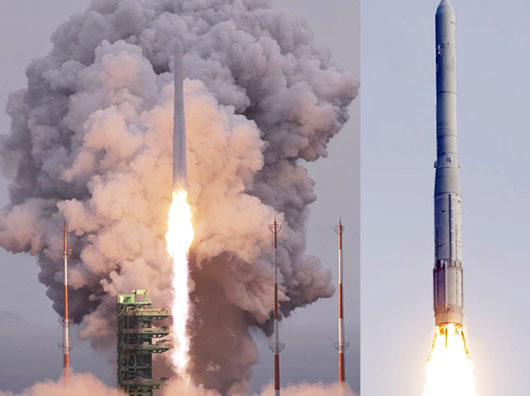Special to CosmicTribune.com, June 7, 2023
By Richard Fisher
On May 25, South Korea launched its third Korean Space Launch Vehicle-II “Nuri” (World) that successful deployed eight satellites.
On May 30, North Korea’s first attempt to launch its new Chollima-1 space launch vehicle ended in failure.

In addition to reflecting that the competition between Communist North Korea and democratic South Korea has entered the realm of space, both space launch vehicles (SLVs) exhibit a similar size and possible capability, but also reflect the priorities of their respective governments.
From South Korea’s Naro Space Center on May 25, the 200-ton, 47-meter length, one ton payload and three-stage Korean Space Launch Vehicle-II (KSLV-II) called Nuri, made a smooth liftoff and deployed eight satellites into Low Earth Orbit (LEO).
The primary payload was the 180-kilogram NEXTSat-2, a South Korean designed X-Band synthetic aperture radar satellite (SAR) placed in a Sun-Synchronous Orbit (SSO) it capable of penetrating cloud cover for a 4-meter resolution, sufficient for urban planning and military targeting.
Seven other, small cubesats were also launched though one did not initiate contact with ground controllers.
South Korea’s space program is designed to achieve scientific and commercial benefits for the people of South Korea, such as ensuring that South Korea profits from a potential future “Space Economy.”
In November 2022, the South Korean government approved funding for the development of the larger KSLV-III, that by 2030 is intended to be able to loft 10-ton payloads to LEO and put 1.8 tons into trans-lunar orbit (TLO) to support South Korea’s ambitious Moon program.
South Korea has joined the U.S.-led Artemis Accords, seeks greater cooperation with U.S. lunar programs, and intends to put a South Korean moon lander on the Moon by 2032.
Meanwhile, the KSLV-II could soon be made available for commercial launches, with an estimated bargain cost of $30 million per launch.
North Korea’s space program is designed primarily to support the military requirements of the North Korean regime while giving its repressive and impoverished Communist regime the ability to demonstrate its power to its people, and to South Korea, Japan and the United States.
In the weeks before the May 30 launch, North Korean state media had featured low resolution images of a new North Korean satellite, with Dictator Kim Jong-Un and his daughter visiting a new North Korean satellite design and production center.
The 300-kg Malligyong-1 optical surveillance satellite did not reach orbit and could still be recovered by South Korea, which has recovered the inter-stage of the Chollima-1.
Full Text . . . . Current Edition . . . . Subscription Information

You must be logged in to post a comment Login